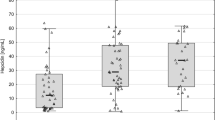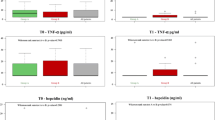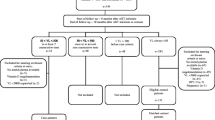Abstract
For people living with HIV, determinants of immunological non-response (INR) to combined antiretroviral therapy (cART) have not been fully elucidated. In a case-control study, we evaluated the influence of the nutritional and antioxidant status in HIV-1 adults whose cART was initiated between January 2001 and December 2013. Cases had persistent CD4 counts < 350/μL vs. > 350/μL for controls, after at least 2 years of cART with persistent viral loads (VL) < 50 copies/mL. Twelve cases and twenty-eight control subjects with the same CD4 count at cART initiation were compared for their nutritional and antioxidant status after age adjustment at dosage assessment. Patients were predominantly male (70%), Caucasian (82%) and at AIDS stage (62%). The median age was 53, and the median CD4 count was 245/mm3 for cases and 630/mm3 for controls after a median time of 7 years on cART. Despite higher energy intakes in cases, anthropometric data was comparable between groups who had similar vitamins B9/B12/C/D/E, zinc, citrulline and glutamine levels. Nine cases (75%) and 8 controls (29%) had hypervitaminosis A (> 2.70 μmol/L) (p = 0.030). Cases had lower erythrocyte resistance when exposed to a controlled free radical attack (p = 0.014). Most cases had hypervitaminosis A and altered antioxidant capacities that could affect immunological response. Wide-scale studies are required, but in the meantime, screening of their vitamin A status must be encouraged in these patients.


Similar content being viewed by others
References
Pakker NG, Notermans DW, de Boer RJ, Roos MT, de WF HA, Leonard JM, Danner SA, Miedema F, Schellekens PT (1998) Biphasic kinetics of peripheral blood T cells after triple combination therapy in HIV-1 infection: a composite of redistribution and proliferation. Nat Med 4:208–214
Semeere AS, Lwanga I, Sempa J, Parikh S, Nakasujja N, Cumming R, Kambugu A, Mayanja-Kizza H (2014) Mortality and immunological recovery among older adults on antiretroviral therapy at a large urban HIV clinic in Kampala, Uganda. J Acquir Immune Defic Syndr 67:382–389
Zoufaly A, der HM A, Kollan C, Bogner JR, Fatkenheuer G, Wasmuth JC, Stoll M, Hamouda O, van Lunzen J (2011) Clinical outcome of HIV-infected patients with discordant virological and immunological response to antiretroviral therapy. J Infect Dis 203:364–371
Serrano-Villar S, Perez-Elias MJ, Dronda F, Casado JL, Moreno A, Royuela A, Perez-Molina JA, Sainz T, Navas E, Hermida JM, Quereda C, Moreno S (2014) Increased risk of serious non-AIDS-related events in HIV-infected subjects on antiretroviral therapy associated with a low CD4/CD8 ratio. PLoS One 9:e85798
Engsig FN, Gerstoft J, Kronborg G, Larsen CS, Pedersen G, Roge B, Jensen J, Nielsen LN, Obel N (2010) Long-term mortality in HIV patients virally suppressed for more than three years with incomplete CD4 recovery: a cohort study. BMC Infect Dis 10:318
Appay V, Fastenackels S, Katlama C, Ait-Mohand H, Schneider L, Guihot A, Keller M, Grubeck-Loebenstein B, Simon A, Lambotte O, Hunt PW, Deeks SG, Costagliola D, Autran B, Sauce D (2011) Old age and anti-cytomegalovirus immunity are associated with altered T-cell reconstitution in HIV-1-infected patients. AIDS 25:1813–1822
Negredo E, Massanella M, Puig J, Perez-Alvarez N, Gallego-Escuredo JM, Villarroya J, Villarroya F, Molto J, Santos JR, Clotet B, Blanco J (2010) Nadir CD4 T cell count as predictor and high CD4 T cell intrinsic apoptosis as final mechanism of poor CD4 T cell recovery in virologically suppressed HIV-infected patients: clinical implications. Clin Infect Dis 50:1300–1308
Baum MK, Shor-Posner G, Lu Y, Rosner B, Sauberlich HE, Fletcher MA, Szapocznik J, Eisdorfer C, Buring JE, Hennekens CH (1995) Micronutrients and HIV-1 disease progression. AIDS 9:1051–1056
Tang AM, Graham NM, Semba RD, Saah AJ (1997) Association between serum vitamin A and E levels and HIV-1 disease progression. AIDS 11:613–620
von Essen MR, Kongsbak M, Schjerling P, Olgaard K, Odum N, Geisler C (2010) Vitamin D controls T cell antigen receptor signaling and activation of human T cells. Nat Immunol 11:344–349
Chepda T, Cadau M, Lassabliere F, Reynaud E, Perier C, Frey J, Chamson A (2001) Synergy between ascorbate and alpha-tocopherol on fibroblasts in culture. Life Sci 69:1587–1596
Suresh DR, Annam V, Pratibha K, Prasad BV (2009) Total antioxidant capacity--a novel early bio-chemical marker of oxidative stress in HIV infected individuals. J Biomed Sci 16:61
Baum MK, Lai S, Sales S, Page JB, Campa A (2010) Randomized, controlled clinical trial of zinc supplementation to prevent immunological failure in HIV-infected adults. Clin Infect Dis 50:1653–1660
Han BY, Wu S, Foo CS, Horton RM, Jenne CN, Watson SR, Whittle B, Goodnow CC, Cyster JG (2014) Zinc finger protein Zfp335 is required for the formation of the naive T cell compartment. Elife 3
Kaiser JD, Campa AM, Ondercin JP, Leoung GS, Pless RF, Baum MK (2006) Micronutrient supplementation increases CD4 count in HIV-infected individuals on highly active antiretroviral therapy: a prospective, double-blinded, placebo-controlled trial. J Acquir Immune Defic Syndr 42:523–528
Roth E (2007) Immune and cell modulation by amino acids. Clin Nutr 26:535–544
Sattler FR, Rajicic N, Mulligan K, Yarasheski KE, Koletar SL, Zolopa A, Alston SB, Zackin R, Bistrian B (2008) Evaluation of high-protein supplementation in weight-stable HIV-positive subjects with a history of weight loss: a randomized, double-blind, multicenter trial. Am J Clin Nutr 88:1313–1321
Koethe JR, Jenkins CA, Shepherd BE, Stinnette SE, Sterling TR (2011) An optimal body mass index range associated with improved immune reconstitution among HIV-infected adults initiating antiretroviral therapy. Clin Infect Dis 53:952–960
Lesgards JF, Lehucher-Michel MP, Vidal N, Prost M, Stocker P (2005) Assessment of antioxidative activity of lipid- and water-soluble vitamins in human whole blood. Comparative analysis between a biological test and chemical methods. Int J Vitam Nutr Res 75:11–18
Olmedilla B, Granado F, Southon S, Wright AJ, Blanco I, Gil-Martinez E, Berg H, Corridan B, Roussel AM, Chopra M, Thurnham DI (2001) Serum concentrations of carotenoids and vitamins A, E, and C in control subjects from five European countries. Br J Nutr 85:227–238
Hannibal L, Lysne V, Bjorke-Monsen AL, Behringer S, Grunert SC, Spiekerkoetter U, Jacobsen DW, Blom HJ (2016) Biomarkers and algorithms for the diagnosis of vitamin B12 deficiency. Front Mol Biosci 3:27
Jones CY, Tang AM, Forrester JE, Huang J, Hendricks KM, Knox TA, Spiegelman D, Semba RD, Woods MN (2006) Micronutrient levels and HIV disease status in HIV-infected patients on highly active antiretroviral therapy in the nutrition for healthy living cohort. J Acquir Immune Defic Syndr 43:475–482
Shivakoti R, Ewald ER, Gupte N, Yang WT, Kanyama C, Cardoso SW, Santos B, Supparatpinyo K, Badal-Faesen S, Lama JR, Lalloo U, Zulu F, Pawar JS, Riviere C, Kumarasamy N, Hakim J, Pollard R, Detrick B, Balagopal A, Asmuth DM, Semba RD, Campbell TB, Golub J, Gupta A (2019) Effect of baseline micronutrient and inflammation status on CD4 recovery post-cART initiation in the multinational PEARLS trial. Clin Nutr 38:1303–1309
Borel P, Desmarchelier C (2017) Genetic variations associated with vitamin A status and vitamin A bioavailability. Nutrients 9
Yatzidis H, Digenis P, Fountas P (1975) Hypervitaminosis A accompanying advanced chronic renal failure. Br Med J 3:352–353
Blaner WS, Li Y, Brun PJ, Yuen JJ, Lee SA, Clugston RD (2016) Vitamin A absorption, storage and mobilization. Subcell Biochem 81:95–125
Yang Q, Graham TE, Mody N, Preitner F, Peroni OD, Zabolotny JM, Kotani K, Quadro L, Kahn BB (2005) Serum retinol binding protein 4 contributes to insulin resistance in obesity and type 2 diabetes. Nature 436:356–362
Schindler K, Haider D, Wolzt M, Rieger A, Gmeinhart B, Luger A, Nowotny P, Ludvik B (2006) Impact of antiretroviral therapy on visfatin and retinol-binding protein 4 in HIV-infected subjects. Eur J Clin Investig 36:640–646
Penniston KL, Tanumihardjo SA (2006) The acute and chronic toxic effects of vitamin A. Am J Clin Nutr 83:191–201
Feskanich D, Singh V, Willett WC, Colditz GA (2002) Vitamin A intake and hip fractures among postmenopausal women. JAMA 287:47–54
Li T, Wu N, Dai Y, Qiu Z, Han Y, Xie J, Zhu T, Li Y (2011) Reduced thymic output is a major mechanism of immune reconstitution failure in HIV-infected patients after long-term antiretroviral therapy. Clin Infect Dis 53:944–951
Michaelsson K, Lithell H, Vessby B, Melhus H (2003) Serum retinol levels and the risk of fracture. N Engl J Med 348:287–294
Promislow JH, Goodman-Gruen D, Slymen DJ, Barrett-Connor E (2002) Retinol intake and bone mineral density in the elderly: the Rancho Bernardo Study. J Bone Miner Res 17:1349–1358
Nollevaux MC, Guiot Y, Horsmans Y, Leclercq I, Rahier J, Geubel AP, Sempoux C (2006) Hypervitaminosis A-induced liver fibrosis: stellate cell activation and daily dose consumption. Liver Int 26:182–186
Omenn GS, Goodman GE, Thornquist MD, Balmes J, Cullen MR, Glass A, Keogh JP, Meyskens FL, Valanis B, Williams JH, Barnhart S, Hammar S (1996) Effects of a combination of beta carotene and vitamin A on lung cancer and cardiovascular disease. N Engl J Med 334:1150–1155
Siems W, Wiswedel I, Salerno C, Crifo C, Augustin W, Schild L, Langhans CD, Sommerburg O (2005) Beta-carotene breakdown products may impair mitochondrial functions--potential side effects of high-dose beta-carotene supplementation. J Nutr Biochem 16:385–397
Caspar-Bauguil S, Maestre N, Segafredo C, Galinier A, Garcia J, Prost M, Periquet B, Penicaud L, Salvayre R, Casteilla L (2009) Evaluation of whole antioxidant defenses of human mononuclear cells by a new in vitro biological test: lack of correlation between erythrocyte and mononuclear cell resistance to oxidative stress. Clin Biochem 42:510–514
Acknowledgements
We thank Sylvie Vandamme, Philippe Choisy, Faïza Ajana, Isabelle Alcaraz, Christophe Allien, Véronique Baclet, Thomas Huleux, Agnès Meybeck, Bertrand Riff and Michel Valette for their help with data acquisition.
Author information
Authors and Affiliations
Corresponding author
Ethics declarations
Conflict of interest
The authors declare that they have no competing interests.
Ethics approval
All procedures in studies involving human participants were performed in accordance with the ethical standards of the institutional and/or national research committee and with the 1964 Helsinki declaration and its later amendments or comparable ethical standards. The study was approved by both local and national ethics committees (CPP, Comité de Protection des Personnes; CNIL, Commission Nationale de l’Informatique et des Libertés. Authorisation number: 1697172).
Informed consent
Eligible individuals were selected from the French Nadis® database which contains clinical and biological information collected during routine practice and for which participants have given their written informed consent for research use. For this study, non-opposition has been verified with the patient.
Additional information
Publisher’s note
Springer Nature remains neutral with regard to jurisdictional claims in published maps and institutional affiliations.
Electronic supplementary material
ESM 1
(DOCX 15 kb)
Rights and permissions
About this article
Cite this article
Melliez, H., Prost, M., Behal, H. et al. Hypervitaminosis A is associated with immunological non-response in HIV-1-infected adults: a case-control study. Eur J Clin Microbiol Infect Dis 39, 2091–2098 (2020). https://doi.org/10.1007/s10096-020-03954-0
Received:
Accepted:
Published:
Issue Date:
DOI: https://doi.org/10.1007/s10096-020-03954-0




